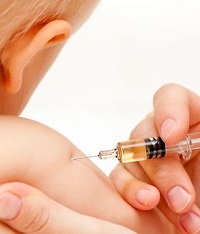Vaccine Side Effects A vaccine side effect can be defined as an "adverse reaction" to a vaccine.Most vaccines have some "local" side effects such as pain, redness, swelling, or a small lump at the site of injection. These side effects usually resolve in a few days, although lumps may take weeks or longer to resolve. Occasionally, vaccines may have some "general" side-effects such as fever, headache, muscle aches and pains, or a rash - these side effects may be caused by the vaccine or may be symptoms of a coincidental illness (e.g. viral infection). Again, these side effects usually resolve in a few days (unless they were caused by a coincidental illness). Rarely, in about 1 in every million vaccinations, a vaccine causes asevere allergic reaction called "anaphylaxis", that begin minutes after the vaccination and includes symptoms such as severe anxiety, hives (itchy skin rash), swelling of the lips and face, difficulty breathing, or collapse. The treatment for anaphylaxis is the immediate injection of adrenaline, which stops the allergic reaction. A vaccine side effect can be defined as an "adverse reaction" to a vaccine.Most vaccines have some "local" side effects such as pain, redness, swelling, or a small lump at the site of injection. These side effects usually resolve in a few days, although lumps may take weeks or longer to resolve. Occasionally, vaccines may have some "general" side-effects such as fever, headache, muscle aches and pains, or a rash - these side effects may be caused by the vaccine or may be symptoms of a coincidental illness (e.g. viral infection). Again, these side effects usually resolve in a few days (unless they were caused by a coincidental illness). Rarely, in about 1 in every million vaccinations, a vaccine causes asevere allergic reaction called "anaphylaxis", that begin minutes after the vaccination and includes symptoms such as severe anxiety, hives (itchy skin rash), swelling of the lips and face, difficulty breathing, or collapse. The treatment for anaphylaxis is the immediate injection of adrenaline, which stops the allergic reaction.
If a vaccine side effect occurs following one of a series of vaccinations, then, unless the side effect was severe, the series of vaccinations should be completed. If you are concerned about completing a series of vaccinations after a vaccine side effect, then consult your immunisation provider. To reduce pain from vaccinations:
To reduce fever from vaccinations:
If you are concerned about any symptoms that occur after vaccination, contact your doctor, community nurse, local hospital or HealthDirect on (Free Call) 1800 022 222. More information • immunise.health.gov.au • ncirs.usyd.edu.au |
|
Covid-19 - Information
Flu Shot Emergency Numbers After Hours 13 74 25 Contact Hours |
Doctors
Appointments Fees About Map Links |
Immunisation
Feedback Local Pharmacies Resources Home |

| 
|

| 
| 
| 
| 
|
|---|---|---|---|---|

| 
| 
| 
| 
|



